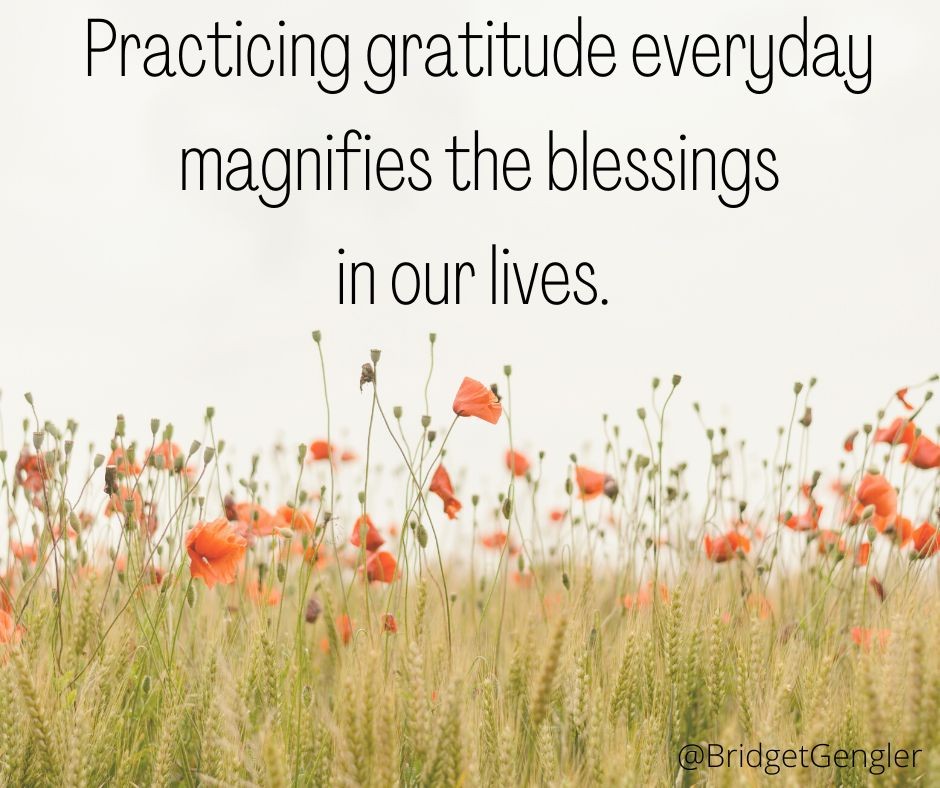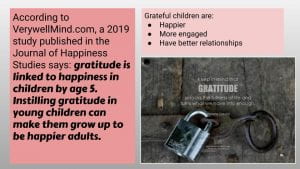Gratitude in the Classroom

Since I started focusing on and teaching gratitude in my class, it has made quite a transformation, not only for me, but for my students. I observed more thoughtfulness and appreciation for each other and for things around us. I witnessed students being more kind to each other and mindful of their actions. It definitely created a calm transition in the morning when students would enter the classroom for morning meeting.
According to VerywellMind.com, a 2019 study published in the Journal of Happiness Studies says: gratitude is linked to happiness in children by age 5. Instilling gratitude in young children can make them grow up to be happier adults. The study showed that grateful kids are happier, more engaged and have better relationships with those around them. Who would not want that for their kids? I know I am much happier, more engaged and have stronger relationships when I focus on what I am thankful for and how I can be a blessing in someone’s life. It brings me tremendous joy. That is what I want for my own children and also for the children I teach during the school year.
So as I prepare for the new school year, I am thinking about how I can be even more intentional with the gratitude practices in my classroom. Since we will start virtual, I created a slide show to introduce my students to what gratitude is and the purpose around it.
https://docs.google.com/presentation/d/1U0ZZrOXnufnU7ynkulVJ7985_iZPA-uTcp6wD-FgIdE/copy
Within this Google slideshow, it references the four parts of gratitude (Bouncebackparenting.com). Notice, Think, Feel and Do. I decided this year, in order to go more in depth, I will focus on being intentional about teaching my students these four parts of gratitude. I will start my year off with the two- notice and think. We will focus on noticing what we are grateful for and thinking about all the goodness around us. I will do that in the following ways:
- Gratitude Journal – I created a digital Gratitude Journal in Google Slides that the students will use on a daily basis to focus on and notice their gratitude. This is a thirty day journal. Day 30 will then lead to daily gratitude writing that will focus on students noticing what they are grateful on a daily basis by just asking the simple question- What are you grateful for?. The thirty day journal sets them up to notice things around them and things in their lives. This hopefully will lead to students being more aware and intentional with their gratitude practice which hopefully will enable them to begin to just think about what they are thankful for each day.
- https://docs.google.com/presentation/d/1SCvm0tSXfEQ3blTzMk563mO_YxbscZR-kghA1n5dYGw/copy (the prompts on the slides were ideas taken from bouncebackparenting.com).
- Gratitude Snaps– A few years ago I learned about book snaps from Tara Martin @TaraMartinEDU and in turn during the month of November, she and Tisha Richmond @tishrich, created gratitude snaps. A gratitude snap is taking a picture of something you are grateful for and adding text to share your gratitude. I was in a Buncee webinar last week and the presenters shared how one could create a gratitude snap using Buncee. I am excited to try that with my students this year. https://buncee.com
- Gratitude Wall– Using Padlet to create a class wall of gratitude is another way that students can be intentional about their noticing, thinking and feeling when it comes to gratitude. https://padlet.com
- Morning Meeting– In my class the past two years, we always expressed our gratitude during our morning meetings. In a virtual world, starting the meeting out with students sharing their gratitude is a good way to begin the day and to build community.
- Flipgrid– During our distance learning in the spring, I made a Flipgrid video every morning and shared my gratitude. I encouraged my students to reply back with a video sharing their gratitude. Again it enabled them to put things into perspective and focus and think about the good around them. It also gives them an opportunity to hear their classmates and make connections.
The fourth part of gratitude is DO. Once my students have practice in expressing gratitude and being intentional with noticing and thinking then the component of DO comes into play. The following are some ways in which I incorporated the DO of gratitude in my class:
- Gratitude Celebration in November: I had students choose randomly a name of a classmate and during that month they needed to focus on how they could express their gratitude to that person. They had the opportnity to make them something and presented it to them at our Friendsgiving right before Thanksgiving break. I wrote about this celebration in a previous post, but I must say it was extremely powerful.
- Veterans Day in November: Students wrote letters of gratitude to Veterans and we presented them to our honorees at our School’s Veterans Day Celebration.
- Gratitude Celebration at the end of the Year: Students chose one person in their life whom they wanted to thank. I turned it into a writing project and they wrote detailed letters that explained to the recipient why they were so grateful for them. They, then invited that person to our end of year celebration where they read the letter to that individual. If their guest could not attend, then we had a phone number where they could reach them and we called them. This was another powerful example of the fourth part of gratitude- DO.
- Kindness Challenge– In January we had a Kindness challenge and students had many examples of how they could be kind in the class, school, home, neighborhood and community. This was an extension of expressing their gratitude.
- Gratitude in the School Community-I separated the students into groups and assigned them a group of people at our school- Cafeteria Staff, Office Staff, Principal, Counselor, Kids’Club Staff, and Recreation Staff. Their task was to make them a poster expressing gratitude. We presented them with the poster and a bucket of snacks.
These are just some ideas of the ways gratitude can be implemented and practiced in a classroom setting. Especially during this time, when school will look different for students, having them focus on something that potentially can bring happiness and joy will only be a positive for their well-being. Gratitude fits well into the social emotional learning which is imperative in all classrooms at this time.
The third part of gratitude – FEEL ,I think becomes clear to the students when they start to put the gratitude into action. They begin to feel the happiness and joy that it brings when they are doing something for someone. When we wrote the letters to the veterans, we happen to receive a letter back from our Veteran who served in World War II. He was so appreciative of the students’ kind words. This really solidified it all for them. They saw and felt what happens when you show your gratitude. Throughout the year, we started to look for that ripple effect in our actions. It empowered my students and gave them the desire to be kind and grateful for each other and everything around them.
Bringing gratitude into the classroom can create experiences for the children that they may have not experienced before. It can build confidence, bring joy and support the social emotional well-being of our students.

